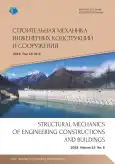Упрощенный выбор оптимальной оболочки вращения
- Авторы: Кривошапко С.Н.1, Иванов В.Н.1
-
Учреждения:
- Российский университет дружбы народов
- Выпуск: Том 15, № 6 (2019)
- Страницы: 438-448
- Раздел: Теория тонких оболочек
- URL: https://journal-vniispk.ru/1815-5235/article/view/346299
- DOI: https://doi.org/10.22363/1815-5235-2019-15-6-438-448
- ID: 346299
Цитировать
Полный текст
Аннотация
Актуальность. Архитекторы и инженеры, работающие с оболочками вращения, используют в своих проектах в основном хорошо зарекомендовавшие себя сферические оболочки, параболоиды, гиперболоиды и эллипсоиды вращения, хотя известны около сотни поверхностей вращения, которые могут быть с успехом применены в строительстве и машиностроении. Методы. Рассматривается оптимизационная задача в проектировании осесимметричной оболочки, подверженной действию внешней нагрузки. Обычно решение этой проблемы заключается в нахождении формы меридиана и в распределении толщины оболочки вдоль меридиана. В статье исследуется более узкая задача, которая заключается в выборе формы оболочки вращения из нескольких известных подклассов, срединные поверхности которых могут быть заданы параметрическими уравнениями. Приводятся результаты статических расчетов куполов различной гауссовой кривизны с одинаковыми габаритными размерами на осесимметричную поверхностную распределенную нагрузку типа собственного веса. Используется вариационноразностный метод. Результаты. Сравнительный анализ результатов расчета шести куполов показал, что с точки зрения напряженно-деформированного состояния лучшие результаты у параболоида вращения и у оболочки вращения кривой z = - a ch( x/b ) вокруг оси Oz . Эти оболочки работают почти в безмоментном состоянии, к чему стремятся проектировщики тонкостенных оболочечных структур. Предложенный критерий оптимальности предлагается назвать «минимальные нормальные напряжения в оболочках вращения с одинаковыми базовыми размерами, граничными условиями и внешними нагрузками».
Об авторах
Сергей Николаевич Кривошапко
Российский университет дружбы народов
Автор, ответственный за переписку.
Email: sn_krivoshapko@mail.ru
доктор технических наук, профессор департамента строительства Инженерной академии
Российская Федерация, Москва, ул. Миклухо-Маклая, 6Вячеслав Николаевич Иванов
Российский университет дружбы народов
Email: sn_krivoshapko@mail.ru
доктор технических наук, профессор департамента строительства Инженерной академии
Российская Федерация, Москва, ул. Миклухо-Маклая, 6Список литературы
- Novozhilov V.V., Chernykh K.F., Mikhaylovskiy E.I. (1991). Lineynaya Teoriya Tonkich obolochek [Linear Theory of Thin Shells]. Leningrad, Politehnika Publ. (In Russ.)
- Ram Ranjan Sahu, Pramod Kumar Gupta. (2015). Blast diffusion by different shapes of domes. Defense Science Journal, 65(1), 77-82.
- Nick B. (2017). Search for dome. 3D Warehouse. Trimble Inc., Nederland.
- Gmirach K.M., Kozlov A.V., Proskurov R.A. (2017). Selection of optimal parameters of elliptical reinforced concrete shell of revolution. International Research Journal, (2(56)-3), 100-104. https://doi.org/10.23670/IRJ.2017.56.049. (In Russ.)
- Zingoni A. (2002). Parametric stress distribution in shell-of-revolution sludge digesters of parabolic ogival form. Thin-Walled Structures, 40, 691-702.
- Zingoni A., Enoma N. (2018). Strength and stability of toroidal domes of prolate elliptic section. Proc. of the IASS Annual Symposia, IASS 2018 Boston Symposium: Shell Structures, 1-8.
- Krivoshapko S.N., Ivanov V.N. (2018). Pseudospherical shells in building industry. Building and Reconstruction, 2(76), 32-40. (In Russ.)
- Krivoshapko S.N., Ivanov V.N. (2018). Catenoidal shells. Promyshlennoe i grazhdanskoe stroitel’stvo, (12), 7-13. (In Russ.)
- Krivoshapko S.N. (2018). Shells of revolution of noncanonical forms. Izvestiya vuzov. Stroitelstvo, 7(715), 66-79. (In Russ.)
- Zingoni A. (2018). Shell Structures in Civil and Mechanical Engineering: Theory and Analysis. ICE Publishing, London.
- Krivoshapko S.N. (2015). History of Development of Architecture of Spatial Structures and Shells with the Bases of Strength Analysis. Moscow: RUDN University. (In Russ.)
- Krivoshapko S.N. (2019). Optimal shells of revolution and main optimizations. Structural Mechanics of Engineering Constructions and Buildings, 15(3), 201-209. http://dx.doi.org/10.22363/1815-5235-2019-15-3-201-209
- Krutov A.V. (2002). Forming curves of fairing. Izv. vuzov. Mashinostroenie, (5), 78-80. (In Russ.)
- Krivoshapko S.N. (2017). On application of parabolic shells of revolution in civil engineering in 2000-2017. Structural Mechanics of Engineering Constructions and Buildings, (4), 4-14. http://dx.doi.org/10.22363/1815-52352017-4-4-14. (In Russ.)
- Belyaeva Z.V. (2015). Geometrical Modeling of Spatial Structures (PhD Diss.). Ekaterinburg. (In Russ.)
- Belyaeva Z.V., Mityushov Е.А. (2008). Mathematical modeling of vaults and domes. Building and Education, 11. Ekaterinburg: UGTU-UPI Publ. (In Russ.)
- Encyclopédie Des Formes Mathematiques Remarquables Surfaces. http://mathcurve.com/surfaces/surfaces.shtml
- Vertinskaya N.D. (2009). The bases of geometric modeling technological processes. Uspehi sovremennogo estestvoznaniya, (5), 84-87. http://www.natural-sciences.ru/ ru/article/view?id=15691. (In Russ.)
- Sabitov I.H. (1986). The research of stiffness and non-bending of analytical surfaces of revolution with a flattening at the pole. Vestnik MGU. Matematika. Mehanika, (5), 29-36. (In Russ.)
- Gbaguidi Aïssè G.L. (2019). Influence of the geometrical researches of surfaces of revolution and translation surfaces on design of unique structures. Structural Mechanics of Engineering Constructions and Buildings, 15(4), 308-314. http://dx.doi.org/10.22363/1815-5235-2019- 15-4-308-314
- Diaz-Severiano J.A., Gomez-Jauregui V., Manchado C., Otero C. (2018). Symmetry in Regular Polyhedra Seen as 2D Möbius Transformations: Geodesic and Panel Domes Arising from 2D Diagrams. Symmetry, (10), 356. DOI: 0.3390/sym10090356
- Rabello F.T., Marcellino N.A., Loriggio D.D. (2016). Automatic procedure for analysis and geometry definition of axisymmetric domes by the membrane theory with constant normal stress. Rev. IBRACON Estrut. Mater., 9(4), São Paulo, July/Aug.
- Abdessalem J., Fakhreddine D., Said A., Mohamed H. (2014). Shape optimization for a hyperelastic axisymmetric structure. Journal of Engineering, Design and Technology, 12(2), 177-194. https://doi.org/10.1108/JEDT10-2011-0072.
- Jasion P., Magnucki K. (2016). Buckling and postbuckling analysis of untypical shells of revolution. Insights and Innovations in Structural Engineering, Mechanics and Computation: Proc. of the 6th International Conference on Structural Engineering, Mechanics and Computation, SEMC 2016, 766-771. doi: 10.1201/9781315641645-125
- Gureeva N.A., Klochkov Yu.V., Nikolaev A.P. (2011). Analysis of shells of revolution on the base of a mixed FEM with using of tensor approximation of design variables. Fundamentalnie issledovaniya, (8-2), 356-362. http://www.fundamental-research.ru/ru/article/view?id=27962. (In Russ.)
- Adriaenssens S., Veenendaal D., Williams Chris J.K. (2014). Shell Structures for Architecture: Form Finding and Optimization. Routledge, 323.
- Bulygin A.V. (1977). On one class of shells of alternating total curvature. Mehanika tvyordogo tela (MTT), 5, 97-104. (In Russ.)
- Ramm E. (1992). Shape finding methods of shells. In F.G. Rammerstorfer (ed.), Nonlinear Analysis of Shells by Finite Elements. Springer - Verlag, Wien. DOI: 10.1007/ 978-3-7091-2604-2
Дополнительные файлы









